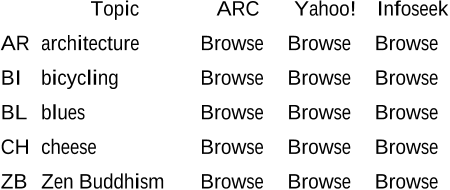expansion step: we add to the root set (1) any document that points to a document in the root set, and (2)
any document that is pointed to by a document in the root set. We perform this expansion step twice (in
Kleinberg’s work, this was performed only once), thus including all pages which are link-distance two
or less from at least one page in the root set. We will call the set of documents obtained in this way the
augmented set. In our experience, the augmented set contained between a few hundred and 3000 distinct
pages, depending on the topic.
We now develop two fundamental ideas. The first idea, due to Kleinberg [Kleinberg97] is that there are
two types of useful pages. An authority page is one that contains a lot of information about the topic. A
hub page is one that contains a large number of links to pages containing information about the topic -
an example of a hub page is a resource list on some specific topic. The basic principle here is the
following mutually reinforcing relationship between hubs and authorities. A good hub page points to
many good authority pages. A good authority page is pointed to by many good hub pages. To convert
this principle into a method for finding good hubs and authorities, we first describe a local iterative
process [Kleinberg97] that "bootstraps" the mutually reinforcing relationship described above to locate
good hubs and authorities. We then present the second fundamental notion underlying our algorithm,
which sharpens its accuracy when focusing on a topic. Finally, we present our overall algorithm and a
description of the experiments that help us fix its parameters.
Kleinberg maintains, for each page p in the augmented set, a hub score, h(p) and an authority score,
a(p). Each iteration consists of two steps: (1) replace each a(p) by the sum of the h(p) values of pages
pointing to p; (2) replace each h(p) by the sum of the a(p) values of pages pointed to by p. Note that this
iterative process ignores the text describing the topics; we remedy this by altering these sums to be
weighted in a fashion described below, so as to maintain focus on the topic. The idea is to iterate this
new, text-weighted process for a number of steps, then pick the pages with the top hub and authority
scores.
To this end we introduce our second fundamental notion: the text around href links to a page p is
descriptive of the contents of p; note that these href’s are not in p, but in pages pointing to p. In
particular, if text descriptive of a topic occurs in the text around an href into p from a good hub, it
reinforces our belief that p is an authority on the topic. How do we incorporate this textual conferral of
authority into the basic iterative process described above? The idea is to assign to each link (from page p
to page q of the augmented set) a positive numerical weight w(p,q) that increases with the amount of
topic-related text in the vicinity of the href from p to q. This assignment is the second, weighting phase
mentioned above. The precise mechanism we use for computing these weights is described in Section
2.1 below; for now, let us continue to the iteration and reporting phase, assuming that this
topic-dependent link weighting has been done.
In the final phase, we compute two vectors h (for hub) and a (for authority), with one entry for each
page in the augmented set. The entries of the first contain scores for the value of each page as a hub, and
the second describes the value of each page as an authority. We construct a matrix W that contains an
entry corresponding to each ordered pair p,q of pages in the augmented set. This entry is w(p,q)
(computed as below) when page p points to q, and 0 otherwise. Let Z be the matrix transpose of W. We
set the vector h equal to 1 initially and iteratively execute the following two steps k times.
a = Wh
h = Za
After k iterations we output the pages with the 15 highest values in h as the hubs, and the 15 highest
values in a as the authorities, without further annotation or human filtering. Thus our process is













